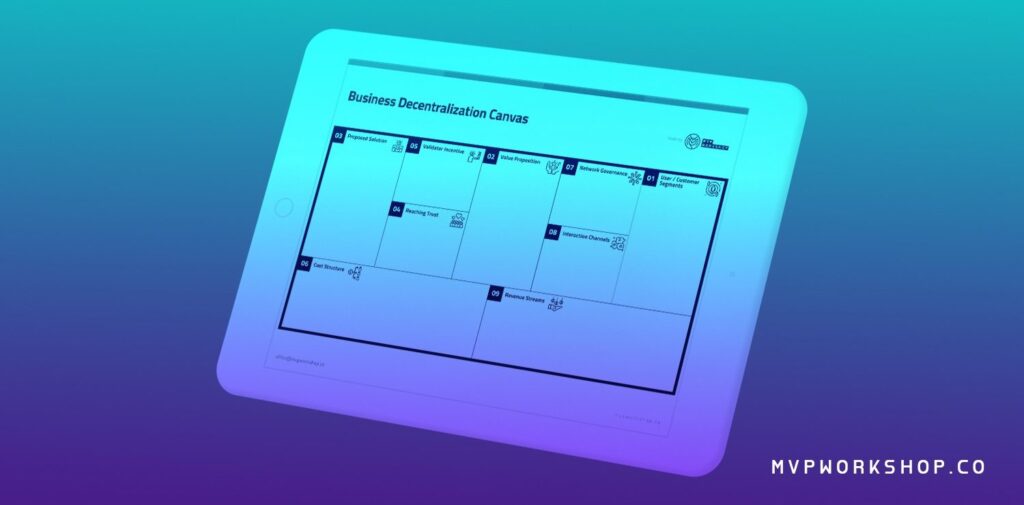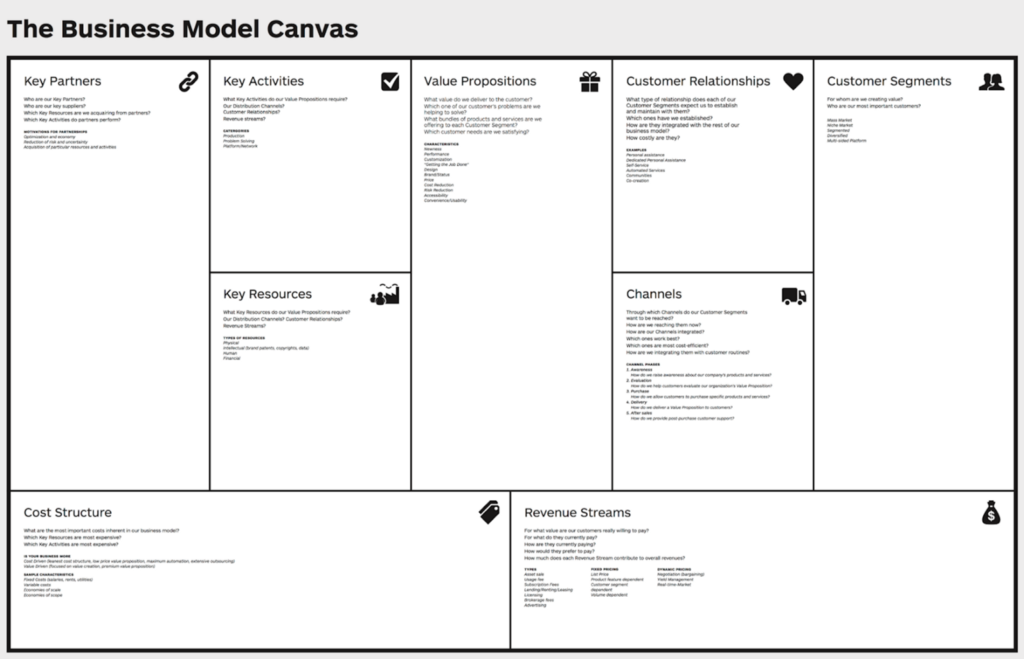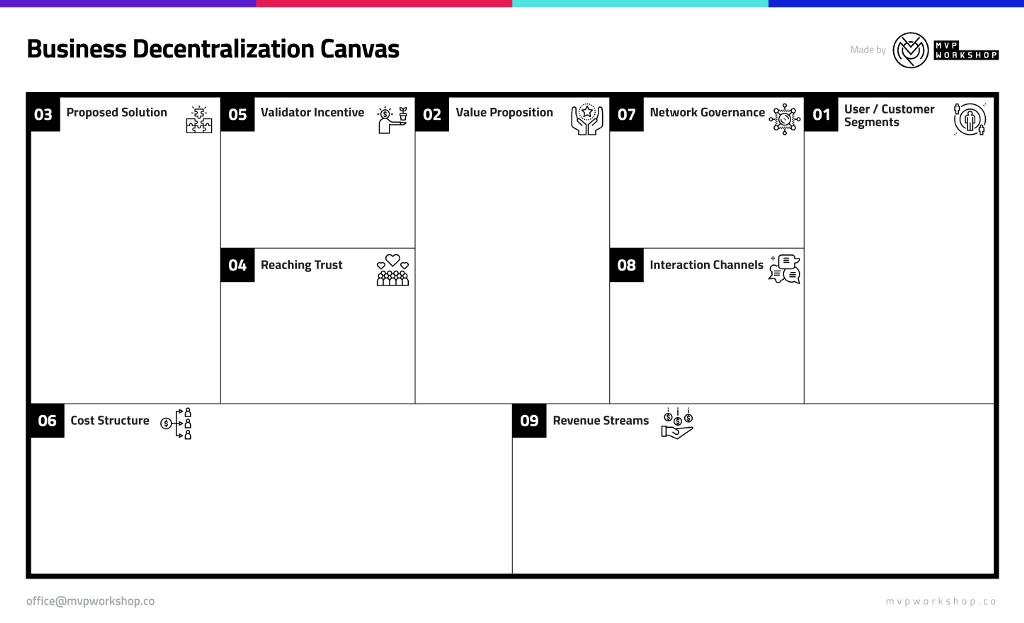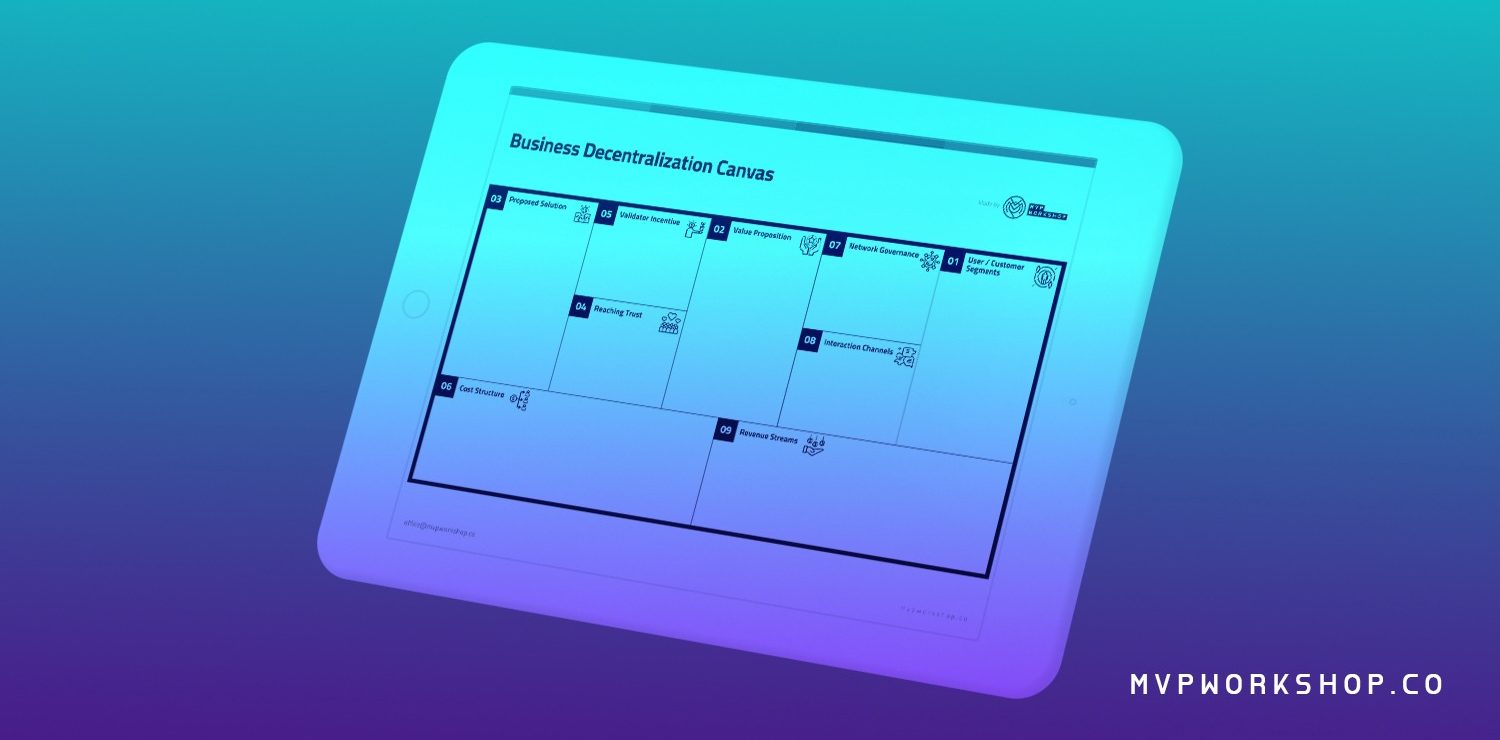When MVP Workshop entered the blockchain product development space a couple of years ago, we had to use the existing tools and frameworks for evaluating decentralized business models which are the cornerstone of every blockchain-related product and service.
We soon realized that this approach is unsuitable for facilitating the level of excellence we aim for in our operations. Two options emerged — we should either start developing our own frameworks from scratch or holistically analyze existing tools and try to adapt or develop them further, making them sustainable in the rapidly evolving industry that is blockchain.

We opted for the second approach, and the result was the Decentralized Business Model Canvas — or DBMC for short — which is based on the widely used Business Model Canvas (BMC) and its variants.
Before we deep dive into what DBMC is and how to use it, let’s take a closer look into how and why we created it.
Centralized vs. Decentralized Business Models
Centralized organizations and business models have been around for centuries, while decentralized business models started to emerge recently, thanks to new technologies and increased access to information.
The key difference between the two models is in the way decisions are made and communicated through organizations. Furthermore, the way the data is stored and distributed is fundamentally different, in addition to the revenue models which have to be rethought from the ground up.
Don’t get us wrong, decentralized organizations and concepts blockchain is built upon are nothing new — they have been around for a couple of decades. However, their widespread implementation is just starting to take roots due to two key factors.
The first one is obvious — technological advancements that can properly facilitate a decentralized business model. However, we won’t be getting into this right now.
Instead, we will focus on the second one, which is an increasing need for decentralized systems in all spheres of our lives, most notably in modern business practices. However, there is an issue here which can be summed up in one question — how do we validate a decentralized business model in a centralized world?
Centralized Organizations
In centralized organizations, all crucial decisions depend on a few key decision makers at the top of an organization, which are then communicated to the rest in a top-down fashion.
Therefore, a couple of important individuals set the policies and rules that are further enforced to other members of the organization. For example, policies created by Apple dictate who can use their platforms like the App Store and how. Distribution of revenue is done in a similar fashion where 30% of all sales from the App Store goes to Apple.
The way data is stored is also one of the key differences. Centralized organizations gather all the important information regarding their users and businesses in centralized databases. That enables them to provide free platforms to their users as the data is often sold to third parties through ads or in other ways that create an additional revenue stream.
But how are decentralized organizations different?
Decentralized Organizations
Decentralized organizations take an alternative approach to decision-making processes. Decisions are made through organizational structures at different levels and then communicated throughout the rest of the organization.
Naturally, the organization also depends on specific governance models the system has in place, and, in the case of a blockchain-based system, whether the chain is public/private and permissioned/permissionless. In some cases, all members participating as primary stakeholders in a decentralized system can decide on the rules and regulations in a blockchain network.
Revenue is distributed in a way that favors those participants that bring the most value to the network (for example, content creators in the case of Scriptarnica), with platform fees being even less than 1% in some cases.
Contrary to centralized business models, the approach to data distribution is completely different. Improved security in decentralized systems ensures that user data is well protected from various kinds of cyber attacks and that it is not sold off to third parties.
How Does MVP Workshop Fit in?
It doesn’t take a nuclear physicist to conclude that MVP Workshop favors the decentralized approach. But before we proceed to talk about our role in DBMC creation, let us properly introduce ourselves.
MVP Workshop is a Blockchain Product Research & Development Studio. We specialize in Decentralized Business Models, Tokenization of Assets and End-to-End Product Development.
Apart from being focused on researching new technologies that can disrupt or further improve existing business models and processes, we strive to define, build and scale real-world products that are focused on Proof-of-Value. That is why we need to constantly grow and improve our knowledge stack, and, after all, that’s why we decided to create DBMC.
MVP Workshop and Business Model Canvas (BMC)
Being very interested in not only adopting technology and facilitating decentralized business models that actually work but also providing the highest level of service possible to our clients and partners, we quickly stumbled upon the following question: “How to validate decentralized business models?”
One of the most popular tools used to describe, design, challenge, and pivot business models is called the Business Model Canvas. However, it was created with a centralized business model in mind.
What Is BMC?
As mentioned before, BMC offers a simple method to gather all the important details about a business model in one place (usually on a single page). That will enable you to evaluate your idea or solution and make key decisions to make it technically and financially viable and sustainable in the long run. It is a great starting point when developing a new business plan.
Every business idea/solution consists of three segments:
- Desirability — What is the demand for this solution? Do your potential customers really need it?
- Feasibility — Is it possible to build your solution? Do you have the resources required for that?
- Viability — How profitable is your solution? Is it sustainable? Can you create revenue streams?
Based on these segments, BMC is divided into nine parts, each pertaining to your business model. Let’s take a closer look.
Desirability:
- Customer Segments
- Value Proposition
- Customer Relationships
- Channels
Feasibility:
- Key Resources
- Key Activities
- Key Partners
Viability:
- Cost Structure
- Revenue Streams

The canvas is not just an everyday checklist. On the contrary, it should help you answer fundamental questions and make an in-depth analysis of your ideas. Now, having this in mind, let’s see what and why we actually did with the DBMC.
Why We Created DBMC
We already stated that we needed a simple way to quickly validate, test and pivot a business model in a decentralized space. The existing tools like Business Model Canvas are usually based on the traditional definition of centralized business models and their characteristics as such were not ideal for the task in front of us. That’s why we started developing our own tools.
How We Did It
As a research and development studio — or even better, as a group of individuals who formed MVP Workshop — we take great care to properly validate the business model as such before starting any type of concrete implementation, and to achieve this we need a well-defined MVP (hence our name). From the very conception of the idea for building MVP Workshop we knew that we need to find and/or create a process for fast and accurate validation of business models, even if they are just a roughly-defined idea. This meant that we were used to working with various Canvases which can set your mind straight by framing and focusing you to answer the most crucial questions before you do anything else, even before blockchain became a thing.
So, we ventured out into the blockchain product space, and we saw it lacks not only industry-proven technology, but also a lot of product-related frameworks and ideas that were developed years before its time. Obviously, a majority of that ‘stuff’ wasn’t directly applicable to blockchain products because the whole concept of decentralization (i.e. disruptive business models) is to turn the industry upside-down in some sense, by leveraging different aspects of technology and evolving human needs, wants and behaviour. That is why we decided to adapt (and sometimes create from scratch) various tools, of which one of the most important ones is the Decentralized Business Model Canvas. It enables us to work fast and adapt even faster, while ensuring the key questions are answered properly, and the alignment between project goals and what is achievable in the real world is always at the forefront of our product development processes.
What Does It Look Like?
With all that in mind, let’s take a look at the Decentralized Business Model Canvas (DBMC) we developed.

- User / Customer Segments — Who are we building the product for
- Value Proposition — What is the value we promise to deliver to our users
- Proposed Solution — How does the solution look like
- Reaching Trust — What mechanisms we use to reach trust
- Validator Incentive — What are the incentives for validators to take part in the network and work in its best interest
- Interaction Channels — What are the best channels for communicating with end-users
- Network Governance — How are decisions made inside the network
- Cost Structure — What are the key costs of doing business
- Revenue Streams — What are the key ways to generate revenue
Note: End? No, the journey doesn’t end here. This was just the first part of our DBMC series which will further discuss this project, its features and practical applications. Make sure to check the second part which we will link here as well as soon as it is published.
If you wish to discover more about our studio, partner up or work with us, feel free to explore our services at mvpworkshop.co
Follow us and subscribe for more company updates and join the conversation on Twitter and LinkedIn. For free business consultation about how blockchain can impact and change your business model, or anything else related to the technology — contact us at [email protected]
Decentralized Business Model Canvas #1 was originally published in MVP Workshop on Medium, where people are continuing the conversation by highlighting and responding to this story.



